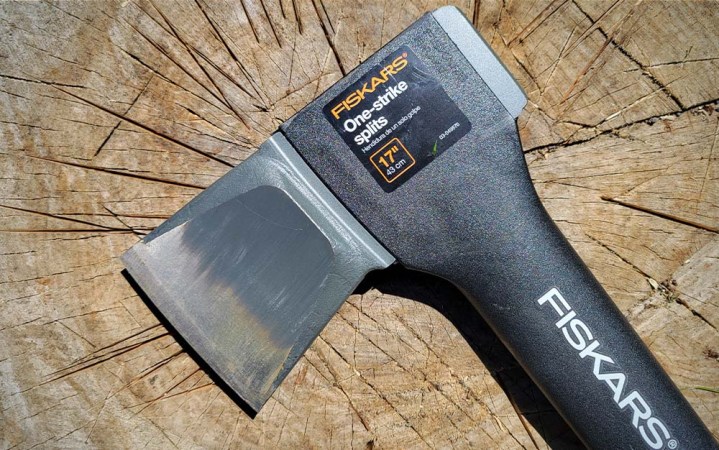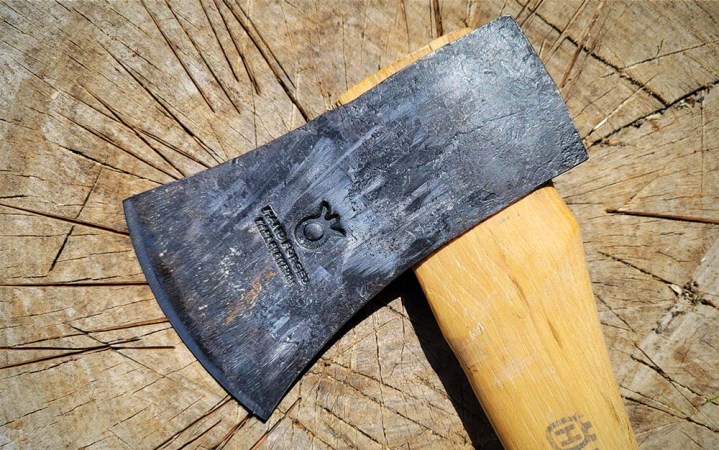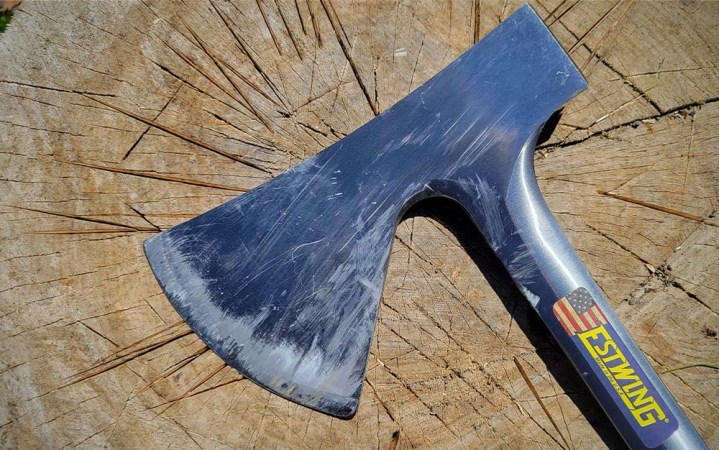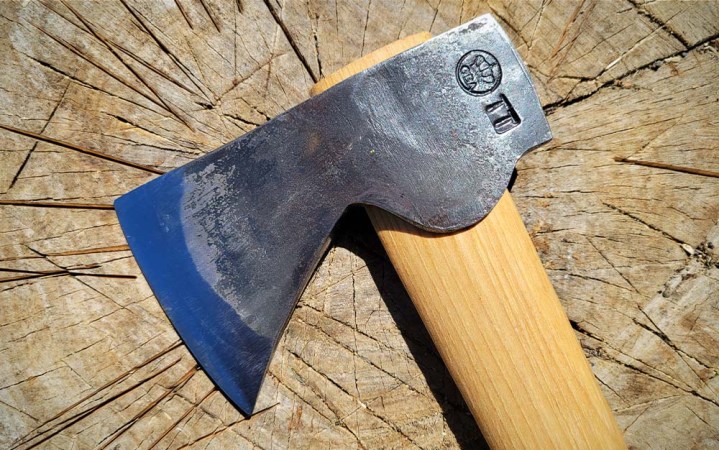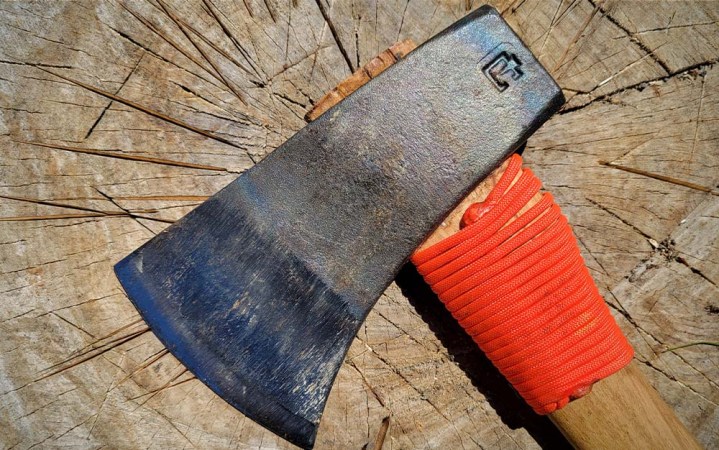The 8 Best Camping Axes of 2024, Tested and Reviewed
We may earn revenue from the products available on this page and participate in affiliate programs. Learn More ›
Camping axes are all designed to do one thing: make wood smaller. Whether they do it by felling a tree, delimbing, splitting, or shaping, an ax needs to efficiently break down wood. As someone who cuts and splits wood to heat my house all winter and enjoys practicing bushcraft, camping, and hunting, I’ve spent some time behind an ax. The issue I’ve found is that not every ax you grab at the local hardware store will cut it. But fear not, I’ve made choosing your next camp ax a little easier by putting the best camping axes through a series of rigorous tests and making my top picks for different applications.
- Best Overall: Hults Bruk Kisa
- Best for Splitting: Fiskars X11 Splitting Axe
- Best Budget Hatchet: Husqvarna Hatchet
- Best Value: Council Tool 28-Inch Boy’s Axe
- Most Durable: Estwing Camper’s Axe
- Best for Crafting and Carving: Hults Bruk Almike Hatchet
- Best Lightweight: Gransfors Bruk Wildlife Hatchet
- Best for Throwing: Council Tool Flying Fox
How I Tested Camping Axes
Overall Length
Different manufacturers use different measurements—some use overall length, and others use the handle length below the head. To provide a standardized measurement, I measured the axes’ overall length from the top of the heads to the bottom of the handles. All measurements presented in the review are overall, so you can get a better idea of how they pack.
Splitting Test
After that, they went straight to the log pile for splitting testing. I split just over two face cords between all the hatchets and axes. A face cord is one row of stacked split wood that is 4-feet tall and 8-feet wide. The logs ranged from 4 to 15 inches in diameter. The biggest logs weren’t really practical for axes of this size, but it let me know the limits for each one.
Chop Test
I performed a chop test on 12-inch diameter black walnut logs. Each ax got 10 full-power swings, and then I measured the cut depth. I did this twice with each one, just in case I had some poor swings. I used the better of the two numbers, assuming that’s what the ax was capable of when I did my part properly.
Shaping and Carving Test
After the chop test, I took 3- to 4-inch diameter logs and sharpened them to a point. This test was all about ergonomics and blade geometry. Heavier axes can feel cumbersome while choking up if the balance is poor, and suitable geometry aids in making this a quick task. Finally, I tried some carving and crafting with each one, rough shaping spoon blanks, and even using them to make feather sticks—one of the best fire starters.
Use in the Field
Aside from the systematic testing, I took these all out around my property for spring cleaning tasks and on scouting trips for turkey season. Clearing brush, pounding stakes, and taking down branches were everyday tasks. Also, there were more than a few overstrikes as a by-product of constantly switching axes and lengths, so the handles received significant handle durability testing. This gave an overall subjective impression of each ax’s comfort, usability, chopping performance, and size.
Best Camping Axes: Reviews & Recommendations
Best Overall: Hults Bruk Kisa
Key Features
- Made in Sweden
- Overall Length: 26 inches
- Head Weight: 2 pounds
- Edge: 3.5 inches
- American hickory handle (haft)
- Chop Test Depth: 2.5 inches
Pros
- Comes with premium leather mask (sheath)
- Mirror polished, shaving sharp edge from the factory
- Handle treated from factory
- Versatile head shape
- Perfect fit and finish
Cons
- Premium quality means a premium price
The Kisa is an absolute dream to work with. It had the deepest cuts in my chopping tests at 2.5-inches deep in seasoned walnut with only 10 swings. It split seasoned hard maple rounds up to 12 inches in two to three blows. Anything under 8 inches took a single swing, except for terribly knotted wood. But, aside from handling the heavy work, the shape of the bit (the cutting part of the ax) on the Kisa allows you to use it for carving, and it’s nimble enough to easily choke up on for detail and fine work like rough shaping of spoons and kuksas.
I was even able to make feather sticks with this thing. Although this ax commands a premium price compared to others, it’s worth every penny, in my opinion. Hults Bruk has been making axes since 1671, and their experience shows in the Kisa. Excellent ergonomics and quality make this a super versatile ax.
Best for Splitting: Fiskars X11 Splitting Axe
Key Features
- Made in Finland
- Overall Length: 17.25 inches
- Weight: 2.7 pounds
- Edge: 3 inches
- Hollow composite handle
- Chop Test Depth: 1.6 inches
Pros
- Comes with a plastic sheath/carry handle
- Maintenance-free handle
- Extremely sharp out of the box
- Orange handle accent makes it easy to find in leaves
Cons
- Comes with plastic sheath/carry handle
- Handle is tough, but the ax is done if it ever breaks—no re-hanging the head
If the only task you do with your camp ax is split, this one is for you. The bit geometry on this ax is perfect for splitting, and it’s obvious as soon as you swing it. The nice thing about Fiskars is that it’s not a one-trick pony like a splitting maul—it will delimb and chop/shape fairly well. Because the handle is hollow, this ax is very weight-biased towards the head.
It’s slightly different from a traditional construction ax, but it works well for chopping and carving. The bit and handle design don’t make carving an easy task, and the handle material doesn’t have quite as much grip as a treated hickory handle, but the swell at the bottom of the handle keeps you locked in with little effort. The coating on the blade won’t last too long, but the edge holds up much better than the paint.
Best Budget Hatchet: Husqvarna Hatchet
Key Features
- Made in Sweden
- Overall Length: 15 inches
- Head Weight: 1 pound
- Edge: 3.5 inches
- Hickory handle
- Chop Test Depth: 1.8 inches
Pros
- Comes with leather sheath
- Comfortable handle shape
- Sharp from the factory
- Multi-purpose head shape
Cons
- Lower quality wood and grain structure in handle
The Husqvarna Hatchet is flat-out impressive. It did well in every test I put it through. This one falls into the hatchet category, and if you aren’t splitting large pieces of wood, it’ll work well. It splits well on seasoned hardwood rounds up to 5 inches in diameter. Great for making kindling, cleaning up brush, clearing shooting lanes for hunting season, and any other camp task. The bit doesn’t have much of a beard (the portion of the blade that hangs down past where the bit and handle meet), so carving with this isn’t ideal, but it’s nimble enough for some shaping for spoons or other carving projects. I like that it’s small enough to throw in a pack for early season scouting, yet capable of taking on almost anything.
Best Value: Council Tool 28-Inch Boy’s Axe
Key Features
- Made in the U.S.
- Overall Length: 28 inches
- Head Weight: 2.25 pounds
- Dayton pattern head
- Edge : 4 inches
- Hickory handle
- Chop Test Depth: 2.1 inches
Pros
- Double Wedged so the head won’t come loose
- Time tested head and handle shape
- Heavier head helps splitting and deeper cuts
- Thinner handle keeps the overall weight down
Cons
- No sheath included (But available separately)
- Thinner handle is less comfortable for larger hands
The Council Tool Boy’s Axe is an excellent ax, and Council Tool managed to make a quality tool in America for a great price. After three years of chopping, splitting, overstrikes, and glancing blows, the head is tight, and the handle is totally intact. The handle length and circumference under the head hinder carving with this ax, but you can still choke up for tasks requiring more finesse.
The thinner handle doesn’t feel quite as comfy as some, and when I bought mine, the hickory was untreated. After several coats of boiled linseed oil, it was ready to go. Well, right after, I bought a sheath for it anyway. I prefer my axes to have a good sheath so I can pack them. Even after purchasing a sheath, the Boy’s Axe was still a great value. Council tool makes a Premium Velvicut line of Axes, but their budget lineup always impresses me.
Most Durable: Estwing Camper’s Axe
Key Features
- Made in the U.S.
- Overall Length: 18.75 inches
- Head Weight: 2.8 pounds
- Edge: 4 inches
- Integrated metal handle with rubber grip
- Chop Test Depth: 1.75 inches
Pros
- One piece forged steel head and handle for unparalleled strength
- Shock reduction grip
- Comes with a nylon sheath with belt loop
- Steel is factory coated to prevent rust
Cons
- Fairly dull out of the box
- Below average splitting performance
My dad used Estwing hammers for as long as I can remember, and my framing hammer is an Estwing. All of them are indestructible, and this camping ax is no different. Short of a cutting torch, you aren’t going to ruin this ax. The handle and head are one forged piece of steel, with a double tempered head, so it won’t be brittle and break under impact. No overstrike will break the handle, the handle won’t dry out and shrink, and the head will never come loose. The poll can be used as a hammer without worry. You can use a sledge hammer to pound it through for heavy splitting and leave it out in the rain for a month and hardly notice.
As far as maintenance, it only needs sharpening. But, the Estwing has a long, thin bit because it doesn’t have to wrap around a handle, and this makes it less than ideal for splitting seasoned hardwood. If you took some time to sharpen this ax, it would pay dividends in splitting and cutting performance because the factory edge leaves something to be desired. But, if you are looking for an ultra-tough, basically maintenance-free ax, the Estwing Campers fits the bill.
Best for Crafting and Carving: Hults Bruk Almike Hatchet
Key Features
- Made in Sweden
- Overall Length: 15 inches
- Head Weight: 1 pound
- Edge: 2.9 inches
- American hickory handle
- Chop Test Depth: 1.75 inches
Pros
- Mirror polished, shaving sharp edge
- Ergonomic handle that is suited for heavy chopping and light carving
- Double wedged head for security
- Premium leather sheath with belt loop included.
- Fully treated handle from factory
Cons
- Premium price
If you’re into bushcraft, this is my choice for you. It’s perfectly suited for making precision cuts for shelters, traps, tools, and camp furniture making, but it’s heavy enough to split firewood and fell trees. It’s the best balanced ax on the list as far as how it feels in hand. The extremely sharp edge makes knocking limbs off a breeze, and it chops deep for such a light head and short handle. Relatively thin cheeks for carving that don’t give up so much that it won’t split well.
I know these axes don’t come cheap, but in this case, I would offer the idiom “buy once, cry once.” The handle was well saturated with boiled linseed oil from the factory, so water intrusion shouldn’t be a problem initially. When you’re using this ax, it just feels right. I really can’t figure out anything bad to say about it. It’s lightweight and strong and excellent for small and big tasks alike.
Best Lightweight: Gransfors Bruk Wildlife Hatchet
Key Features
- Made in Sweden
- Overall Length: 13 inches
- Head Weight: Just under 1 pound
- Edge: 3 inches
- Hickory handle
- Chop Test Depth: 1.5 inches
Pros
- Extremely sharp factory edge
- Easily Packable
- Excellent fit and finish
- Premium leather sheath included
- Controllable for small/fine tasks
Cons
- Premium quality means a premium price
The Gransfors Bruk Wildlife Hatchet punches above its weight, and you can thank excellent geometry and handle design for that. With its lighter head and thinner handle, the Wildlife Hatchet packs easily and will be my choice when heading to Colorado for an elk hunt this fall. I’ll be backpacking it several miles to my basecamp because its utility is worth the weight. This would also make a great ax to bring on a scouting trip to clear branches and saplings and make natural ground blinds.
The longer beard on the bit makes it good for carving, but the front of the handle behind the beard isn’t as comfortable as some others. The generous swell at the base of the handle locks your hand in when you’re swinging hard, and as with most of the other axes, there is a lanyard hole drilled for tying a loop to help grip if desired. It’s great for splitting smaller wood to make kindling, but if you plan on a lot of splitting at camp, other options might work better.
Best for Throwing: Council Tool Flying Fox
Key Features
- Made in the U.S.
- Overall Length: 16 inches
- Head Weight: 1.62 pounds
- Edge: 3.8 inches
- Hickory handle
- Chop Test Depth: 1.75 inches
Pros
- Heavier head aids in splitting
- Comfortable handle ergonomics
- Hardened poll suitable for driving metal stakes and nails
- Double wedged for strength
- Good for work and play
Cons
- No sheath included
I won my Flying Fox in a social media giveaway a few years ago and have been using it ever since. It’s been a workhorse kindling maker during the long winter where I burn wood to heat the house, and it’s been on several camping trips with me. It’s not as balanced or refined for chopping as some other axes, but it’s perfectly balanced when you want to try your hand at some throwing.
It took me a while to get the hang of it, and I had some terrible throws, which led to some rough impacts on the Flying Fox, but it hasn’t budged or loosened at all. If you want your ax to pull double duty and you want to mix business and pleasure, the Council Tool Flying Fox might be the ticket for you. This is also a pretty budget-friendly hatchet, and if you’re just looking for a quality utility tool, the Flying Fox will work well for that too.
Things to Consider When Buying a Camping Axe
The most significant factors in determining the best camping ax for you include: intended use, construction, and use frequency.
Ax Terminology
Understanding ax terminology will make choosing an ax much easier. Here are important terms to know:
- Haft: The ax handle
- Head: The general term for the business part of an ax
- Bit: Portion of the head from the sharpened edge to the front of the haft
- Eye: The hole in the head that the haft goes through
- Wedge: Piece of wood and/or metal that is pounded into the slot (in the top of the ax haft) to wedge the head on
- Poll: Back of the head of the ax
- Beard: The portion of the ax bit that hangs down on the bottom
- Cheek: The part of the bit behind the sharpened edge bevel
Intended Use for your Camping Axe
Axes are designed to cut or split, so you’ll first decide which attribute is most important. Bit geometry plays a huge role in those rolls. If you’re almost exclusively splitting, don’t buy an ax with a thin bit and a light head. And if you’re doing a bunch of limbing, chopping, and felling, don’t buy an ax with a thick cheek and chunky bit.
Another factor is handle length. If you’re backpacking, a 28-inch handle is too long to pack, but that long handle is ideal for felling bigger trees and heavy splitting. Smaller handles also offer more control for carving and detail tasks.
Camping Axe Construction
Most axes have a head with an eye and hickory handle that goes through the eye and is wedged in place with wood and metal wedges. These axes can be rehung if the handle breaks. You can even do it yourself, which is a fun activity.
But, wood and forged carbon steel require care. The wood will need to be oiled or waxed to keep it from drying out and prevent water absorption. To condition my handles I use Straight Grain Supply Axe Balm. It’s a mixture of beeswax and boiled linseed oil and will condition and preserve the haft (handle) and keep the head from rusting. If you don’t want to occasionally maintain your ax, look for synthetic handle construction or a coated metal like on the Estwing.
Read Next: How to Sharpen an Axe
Frequency of Use
Are you going to use this tool once a year, once a month, once a week, or nearly every day? The more frequently you use it, the more important things like handle shape, balance, and maintenance become. Also, the more you use it, the more you will appreciate having a top-quality tool. You’ll have to learn to sharpen and bring the cheeks back as you wear the edge down. Speaking of sharpening, most people use a puck-style sharpener or a file to sharpen axes. I use a Straight Grain Supply puck-style dual grit sharpening stones. An 80/220 for getting out nicks and dings, and a 220/400 to get it nice and sharp.
FAQs
You can head down to a hardware store and buy a cheap hatchet or ax for about $20 and I have done it. I won’t do it again. For about $50, you can get a nice American-made Council Tool, and if you’re looking for more premium offerings, some axes cost over $400. The Hults Bruk Kisa is the most expensive on the best camping axes list, at just under $200, and I can say it’s worth it. My grandkids (that I don’t have yet) will be chopping wood with it when I’m long gone.
Yes, If you follow some safety guidelines. First, no one should be within at least 10 yards of you in any direction, especially in the front and behind. That gives room for things like flying wood chips, a slip of the hand, or a broken head. Second, learn how to swing an ax or hatchet.
Here are some basic rules to keep in mind:
-When you raise the ax, have one hand by the head and the other at the base of the grip.
-As you swing down, slide your upper hand down to meet your lower hand before the strike. You’re transitioning from control to power and leverage.
-Especially on smaller hatchets and axes, start out on your knees so that if you miss or glance off, the ax won’t overtravel and hit your legs or feet. It will just hit the ground. This is where most injuries come from.
-Wear glasses or goggles for flying wood chips.
If your handle is totally untreated, the adage for treating it with boiled linseed oil is once an hour for seven hours, then once a day for seven days, then once a week for a month, and once a month for a year, then once a year. I’ve never done it that way, but that’s what they say is optimal. The first day I get it, I will hit it as much as it will soak up, then I do it once a day for a few days, and then I’m done. They usually stop absorbing it by then. If an ax comes treated, I give it the oil/wax a couple of times a year unless it sees a bunch of rain or gets submerged in water—then I’ll hit it a little more. Wax the head if it’s going into storage or see a lot of moisture.
An ax has a longer handle and a heavier head than a hatchet. Axes are used for splitting, felling, and delimbing, while hatchets are used for lighter tasks and can be carried on a belt.
Final Thoughts on the Best Camping Axes
There are a surprising number of ax types available. Some are super-specialized for squaring logs or splitting huge rounds, while others are all-rounders made to handle most tasks competently. There are various types of constructions with composite handles becoming more and more popular. Some axes are eight inches, and some are 36 inches. Each has its merit, but the best camping axes, especially the ones on this list, will serve you well however you spend your time outdoors making big pieces of wood smaller.
- Best Overall: Hults Bruk Kisa
- Best for Splitting: Fiskars X11 Splitting Axe
- Best Budget Hatchet: Husqvarna Hatchet
- Best Value: Council Tool 28-Inch Boy’s Axe
- Most Durable: Estwing Camper’s Axe
- Best for Crafting and Carving: Hults Bruk Almike Hatchet
- Best Lightweight: Gransfors Bruk Wildlife Hatchet
- Best for Throwing: Council Tool Flying Fox
The post The 8 Best Camping Axes of 2024, Tested and Reviewed appeared first on Outdoor Life.


